transmission oil YAMAHA WR 250F 2010 Owners Manual
[x] Cancel search | Manufacturer: YAMAHA, Model Year: 2010, Model line: WR 250F, Model: YAMAHA WR 250F 2010Pages: 232, PDF Size: 13.94 MB
Page 10 of 232

CONTENTS
CHAPTER 1
GENERAL INFOR-
MATION
LOCATION OF
IMPORTANT LABELS ..... 1-1
DESCRIPTION ................. 1-5
CONSUMER
INFORMATION................. 1-6
INCLUDED PARTS .......... 1-6
IMPORTANT
INFORMATION................. 1-6
CHECKING OF
CONNECTION .................. 1-7
SPECIAL TOOLS ............. 1-8
CONTROL FUNCTIONS.. 1-12
MULTI-FUNCTION
DISPLAY ........................ 1-13
STARTING AND
BREAK-IN ...................... 1-18
TORQUE-CHECK
POINTS........................... 1-20
CLEANING AND
STORAGE ...................... 1-21
CHAPTER 2
SPECIFICATIONS
GENERAL
SPECIFICATIONS ............ 2-1
MAINTENANCE
SPECIFICATIONS ............ 2-3
TIGHTENING
TORQUES ...................... 2-12
LUBRICATION
DIAGRAMS .................... 2-19
CABLE ROUTING
DIAGRAM ....................... 2-21
CHAPTER 3
REGULAR INSPEC-
TION AND AD-JUSTMENTS
PERIODIC MAINTENANCE
CHART FOR THE EMISSION
CONTROL SYSTEM (For
Canada) ............................ 3-1
GENERAL MAINTENANCE
AND LUBRICATION CHART
(For Canada) .................... 3-2
MAINTENANCE INTER-
VALS FOR COMPETITION
USE ................................... 3-3
PRE-OPERATION
INSPECTION AND
MAINTENANCE................ 3-7
ENGINE ............................ 3-8
CHASSIS ........................ 3-19
ELECTRICAL ................. 3-29
CHAPTER 4 TUNING
ENGINE
(Except for Canada) ........ 4-1
CHASSIS .......................... 4-5
CHAPTER 5
ENGINE
RADIATOR ....................... 5-1
CARBURETOR................. 5-4
AIR INDICTOIN
SYSTEM ......................... 5-12
CAMSHAFTS.................. 5-14
CYLINDER HEAD........... 5-19
VALVES AND VALVE
SPRINGS ........................ 5-21
CYLINDER AND
PISTON ........................... 5-25
CLUTCH ......................... 5-29 OIL FILTER ELEMENT
AND WATER PUMP .......5-34
BALANCER ....................5-39
OIL PUMP .......................5-41
KICK SHAFT AND SHIFT
SHAFT ............................5-44
AC MAGNETO AND
STARTER CLUTCH........5-49
ENGINE REMOVAL........5-54
CRANKCASE AND
CRANKSHAFT ...............5-58
TRANSMISSION,
SHIFT CAM AND
SHIFT FORK ...................5-64
CHAPTER 6
CHASSIS
FRONT WHEEL AND
REAR WHEEL ..................6-1
FRONT BRAKE AND
REAR BRAKE ..................6-6
FRONT FORK .................6-16
HANDLEBAR..................6-23
STEERING ......................6-27
SWINGARM ....................6-31
REAR SHOCK
ABSORBER ....................6-36
CHAPTER 7
ELECTRICAL
ELECTRICAL COMPO-
NENTS AND WIRING
DIAGRAM .........................7-1
IGNITION SYSTEM...........7-3
ELECTRIC STARTING
SYSTEM............................7-5
CHARGING SYSTEM .....7-13
THROTTLE POSITION
SENSOR SYSTEM .........7-15
LIGHTING SYSTEM .......7-18
SIGNALING SYSTEM.....7-20
Page 28 of 232

1-18
STARTING AND BREAK-IN
STARTING AND BREAK-IN
FUEL
Always use the recommended fuel as
stated below. Also, be sure to use
new gasoline.
Use only unleaded gasoline. The
use of leaded gasoline will cause
severe damage to the engine inter-
nal parts such as valves, piston
rings, and exhaust system, etc.
If knocking or pinging occurs, use a
different brand of gasoline or higher
octane grade.
• For refueling, be sure to stop the
engine and use enough care not
to spill any fuel. Also be sure to
avoid refueling close to a fire.
• Refuel after the engine, exhaust pipe, etc. have cooled off.
Gasohol (For Canada)
There are two types of gasohol: gas-
ohol containing ethanol and that con-
taining methanol. Gasohol containing
ethanol can be used if the ethanol
content does not exceed 10%. Gaso-
hol containing methanol is not recom-
mended by Yamaha because it can
cause damage to the fuel system or
vehicle performance problems.
HANDLING NOTE
Never start or run the engine in a
closed area. The exhaust fumes
are poisonous; they can cause
loss of consciousness and death
in a very short time. Always oper-
ate the machine in a well-ventilated
area.
• The carburetor on this machine has a built-in accelerator pump.
Therefore, when starting the en-
gine, do not operate the throttle
or the spark plug will foul.
• Unlike a two-stroke engine, this engine cannot be kick started
when the throttl e is open be-
cause the kickstarter may kick
back. Also, if the throttle is open
the air/fuel mixture may be too
lean for the engine to start.
• Before starting the machine, per- form the checks in the pre-opera-
tion check list.
AIR FILTER MAINTENANCE
According to "CLEANING THE AIR
FILTER ELEMENT" section in the
CHAPTER 3, apply the foam-air-filter
oil or its equivalent to the element.
(Excess oil in the element may ad-
versely affect engine starting.)
STARTING A COLD ENGINE
This model is equipped with an igni-
tion circuit cut-off system. The engine
can be started under the following
conditions.
• When the transmission is in neutral.
• When the clutch is disengaged with
the transmission in any position.
However, it is recommended to shift
into neutral before starting the en-
gine.
1. Inspect the coolant level.
2. Turn the fuel cock to "ON".
3. Push on the main switch to "ON".
4. Shift the transmission into neutral.
5. Fully open the cold starter knob "1".
6. Start the engine by pushing the start switch or by kicking the kick-
starter crank.
If the engine fails to start by pushing
the start switch, re lease the switch,
wait a few seconds, and then try
again. Each starting attempt should
be as short as possible to preserve
the battery. Do not crank the engine
more than 10 seconds on any one at-
tempt. If the engine does not start
with the starter motor, try using the
kickstarter crank.
• If the starter motor will no t turn
when pushing the start switch,
stop pushing it immediately and
kick start the engine in order to
avoid the load on the motor.
• Do not open the throttle while kicking the kickstarter crank.
Otherwise, the kickstarter crank
may kick back.
7. Return the cold starter knob to its original position and run the en-
gine at 3,000–5,000 r/min for 1 or
2 minutes.
Since this model is equipped with an
accelerator pump, if the engine is
raced (the throttle opened and
closed), the air/fuel mixture will be too
rich and the engine may stall. Also
unlike a two-stroke engine, this model
can idle.
Do not warm up th e engine for ex-
tended periods of time.
STARTING A WARM ENGINE
Do not operate the cold starter knob
and throttle. Pull the hot starter lever
"1" and start the engine by pushing
the start switch or by kicking the kick-
starter crank forcefully with a firm
stroke. As soon as the engine starts,
Release the hot starter lever to close
the air passage.
Recommended fuel:
Premium unleaded
gasoline only with a re-
search octane number
of 95 or higher.
Page 139 of 232
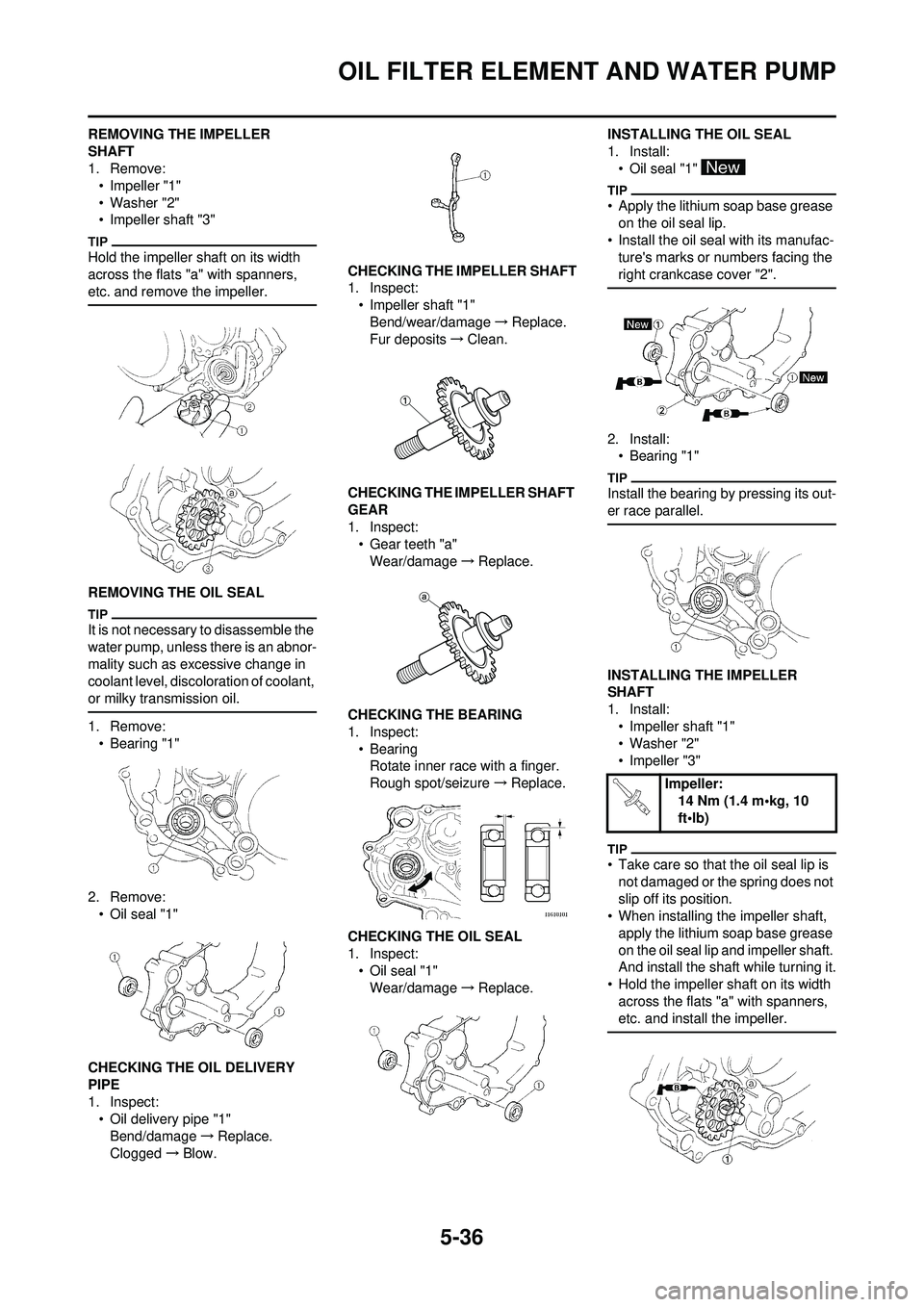
5-36
OIL FILTER ELEMENT AND WATER PUMP
REMOVING THE IMPELLER
SHAFT
1. Remove:• Impeller "1"
• Washer "2"
• Impeller shaft "3"
Hold the impeller shaft on its width
across the flats "a" with spanners,
etc. and remove the impeller.
REMOVING THE OIL SEAL
It is not necessary to disassemble the
water pump, unless there is an abnor-
mality such as excessive change in
coolant level, discoloration of coolant,
or milky transmission oil.
1. Remove:• Bearing "1"
2. Remove: • Oil seal "1"
CHECKING THE OIL DELIVERY
PIPE
1. Inspect: • Oil delivery pipe "1"Bend/damage →Replace.
Clogged →Blow. CHECKING THE IMPELLER SHAFT
1. Inspect:
• Impeller shaft "1"Bend/wear/damage →Replace.
Fur deposits →Clean.
CHECKING THE IMPELLER SHAFT
GEAR
1. Inspect: • Gear teeth "a"Wear/damage →Replace.
CHECKING THE BEARING
1. Inspect: •BearingRotate inner race with a finger.
Rough spot/seizure →Replace.
CHECKING THE OIL SEAL
1. Inspect: • Oil seal "1"Wear/damage →Replace. INSTALLING THE OIL SEAL
1. Install:
• Oil seal "1"
• Apply the lithium soap base grease on the oil seal lip.
• Install the oil seal with its manufac- ture's marks or numbers facing the
right crankcase cover "2".
2. Install:• Bearing "1"
Install the bearing by pressing its out-
er race parallel.
INSTALLING THE IMPELLER
SHAFT
1. Install:• Impeller shaft "1"
• Washer "2"
• Impeller "3"
• Take care so that the oil seal lip is
not damaged or the spring does not
slip off its position.
• When installing the impeller shaft,
apply the lithium soap base grease
on the oil seal lip and impeller shaft.
And install the shaft while turning it.
• Hold the impeller shaft on its width across the flats "a" with spanners,
etc. and install the impeller.
Impeller: 14 Nm (1.4 m•kg, 10
ft•lb)
Page 163 of 232
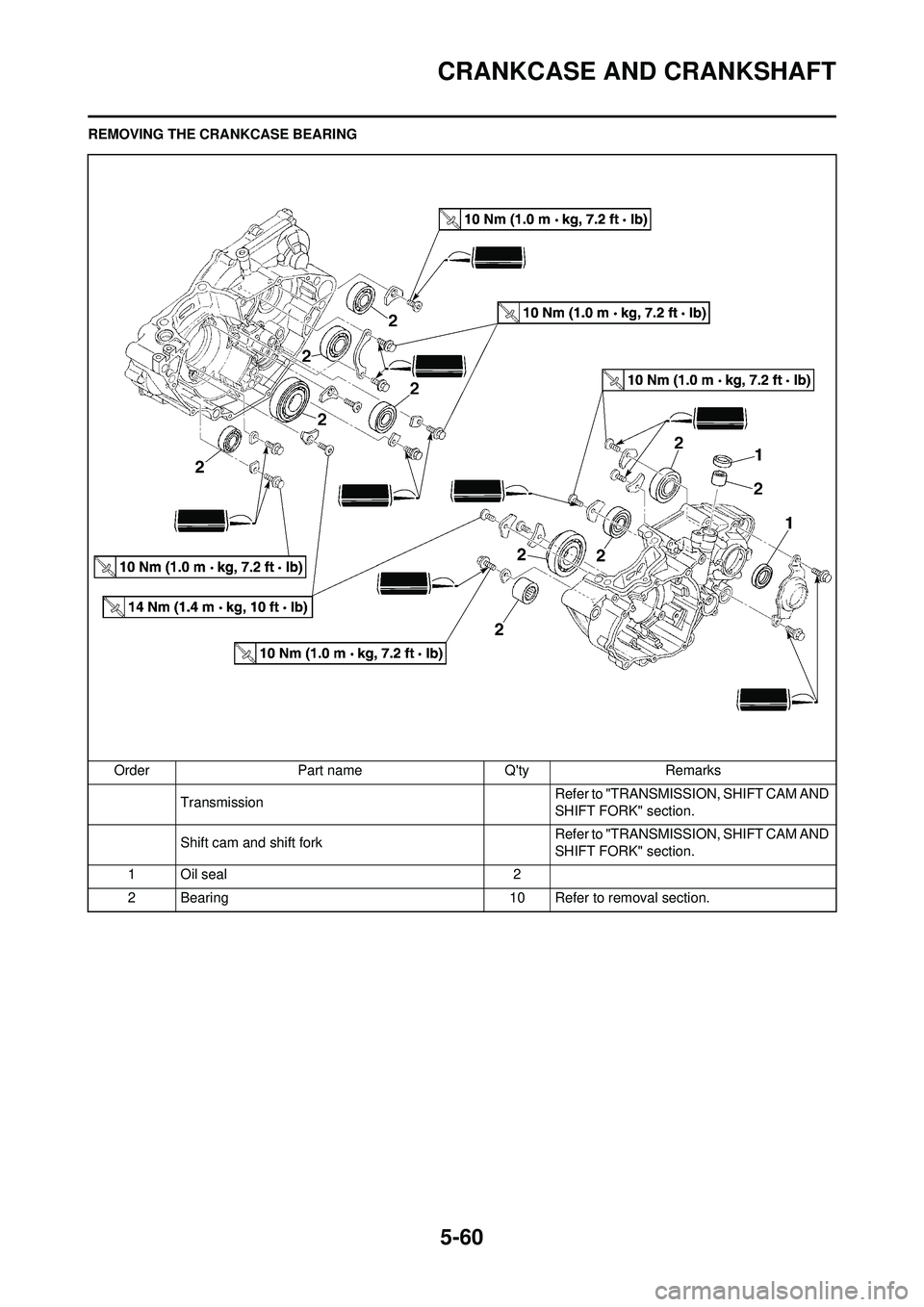
5-60
CRANKCASE AND CRANKSHAFT
REMOVING THE CRANKCASE BEARINGOrder Part name Q'ty Remarks Transmission Refer to "TRANSMISSION, SHIFT CAM AND
SHIFT FORK" section.
Shift cam and shift fork Refer to "TRANSMISSION, SHIFT CAM AND
SHIFT FORK" section.
1 Oil seal 2
2 Bearing 10 Refer to removal section.
Page 164 of 232
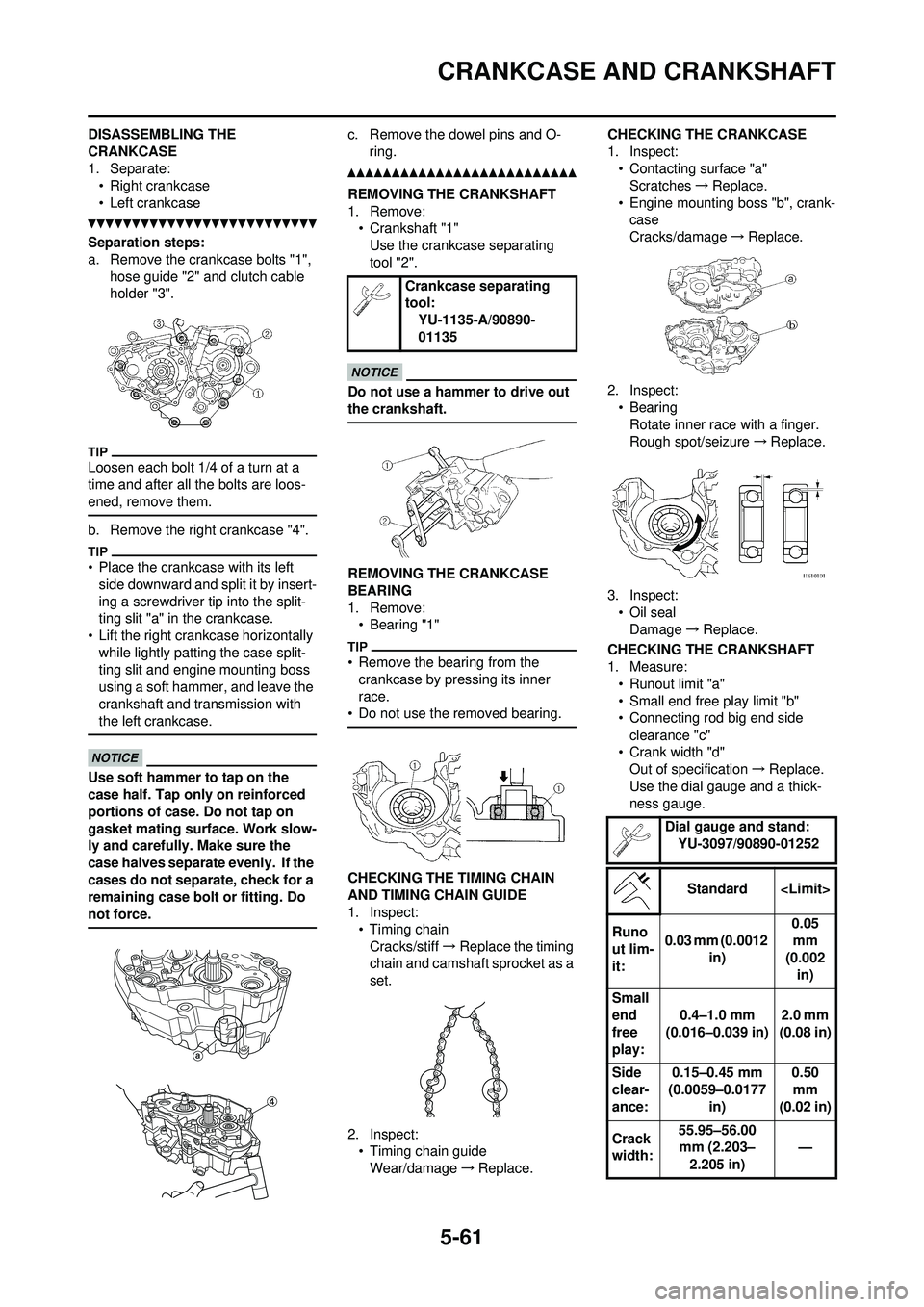
5-61
CRANKCASE AND CRANKSHAFT
DISASSEMBLING THE
CRANKCASE
1. Separate:• Right crankcase
• Left crankcase
Separation steps:
a. Remove the crankcase bolts "1", hose guide "2" and clutch cable
holder "3".
Loosen each bolt 1/4 of a turn at a
time and after all the bolts are loos-
ened, remove them.
b. Remove the right crankcase "4".
• Place the crankcase with its left
side downward and split it by insert-
ing a screwdriver tip into the split-
ting slit "a" in the crankcase.
• Lift the right crankcase horizontally while lightly patting the case split-
ting slit and engine mounting boss
using a soft hammer, and leave the
crankshaft and transmission with
the left crankcase.
Use soft hammer to tap on the
case half. Tap only on reinforced
portions of case. Do not tap on
gasket mating surface. Work slow-
ly and carefully. Make sure the
case halves separate evenly. If the
cases do not separate, check for a
remaining case bolt or fitting. Do
not force.
c. Remove the dowel pins and O-
ring.
REMOVING THE CRANKSHAFT
1. Remove:• Crankshaft "1"
Use the crankcase separating
tool "2".
Do not use a hammer to drive out
the crankshaft.
REMOVING THE CRANKCASE
BEARING
1. Remove:•Bearing "1"
• Remove the bearing from the crankcase by pressing its inner
race.
• Do not use the removed bearing.
CHECKING THE TIMING CHAIN
AND TIMING CHAIN GUIDE
1. Inspect: • Timing chain
Cracks/stiff →Replace the timing
chain and camshaft sprocket as a
set.
2. Inspect: • Timing chain guideWear/damage →Replace. CHECKING THE CRANKCASE
1. Inspect:
• Contacting surface "a"Scratches →Replace.
• Engine mounting boss "b", crank- case
Cracks/damage →Replace.
2. Inspect: • BearingRotate inner race with a finger.
Rough spot/seizure →Replace.
3. Inspect: • Oil sealDamage →Replace.
CHECKING THE CRANKSHAFT
1. Measure: • Runout limit "a"
• Small end free play limit "b"
• Connecting rod big end side clearance "c"
• Crank width "d" Out of specification →Replace.
Use the dial gauge and a thick-
ness gauge.
Crankcase separating
tool: YU-1135-A/90890-
01135
Dial gauge and stand: YU-3097/90890-01252
Standard
Runo
ut lim-
it: 0.03 mm (0.0012
in) 0.05
mm
(0.002 in)
Small
end
free
play: 0.4–1.0 mm
(0.016–0.039 in) 2.0 mm
(0.08 in)
Side
clear-
ance: 0.15–0.45 mm
(0.0059–0.0177 in) 0.50
mm
(0.02 in)
Crack
width: 55.95–56.00
mm (2.203–
2.205 in) —
Page 165 of 232

5-62
CRANKCASE AND CRANKSHAFT
CHECKING THE OIL STRAINER
1. Inspect:• Oil strainer
Damage →Replace.
CHECKING THE OIL DELIVERY
PIPE 2
1. Inspect: • Oil delivery pipe 2 "1"
• O-ring "2"
Damage →Replace.
• Oil orifice "a" Clogged →Blow.
INSTALLING THE CRANKCASE
BEARING
1. Install: • Bearing
• Bearing stopper
• Bolt (bearing stopper)
• Screw (bearing stopper) • Screw [bearing stopper (crank-
shaft)] "1"
To left and right crankcase.
• Install the bearing by pressing its outer race parallel.
• To prevent the screw [bearing stop- per (crankshaft)] from becoming
loose, crush the screw head periph-
ery "a" into the concave "b" using a
punch etc. In so doing, take care
not to damage the screwdriver re-
ceiving hole in the screw head.
INSTALLING THE CRANKSHAFT
1. Install:
• Crankshaft "1"Use the crankshaft installing tool
"2", "3", "4" and "5".
• Hold the connecting rod at top dead center with one hand while turning
the nut of the installing tool with the
other. Operate the installing tool un-
til the crankshaft bottoms against
the bearing.
• Before installing the crankshaft, clean the contacting surface of
crankcase.
Do not use a hammer to drive in
the crankshaft.
A. For USA and CDN
B. Except for USA and CDN
2. Check:
• Shifter operation
• Transmission operationUnsmooth operation →Repair.
3. Install: • Oil strainer "1"
• Bolt (oil strainer) "2"
4. Apply: • Sealant
On the right crankcase "1".
Clean the contacting surface of left
and right crankcase before applying
the sealant.
Bolt (bearing stopper): 10 Nm (1.0 m•kg, 7.2
ft•lb)
Screw (bearing stopper): 10 Nm (1.0 m•kg, 7.2
ft•lb)
Screw [bearing stopper
(crankshaft)]:14 Nm (1.4 m•kg, 10
ft•lb)
Crankshaft installing pot
"2": YU-90050/90890-01274
Crankshaft installing bolt
"3": YU-90050/90890-01275
Adapter (M12) "4": YU-90063/90890-01278
Spacer (crankshaft in-
staller) "5": YU-91044/90890-04081
Bolt (oil strainer):
10 Nm (1.0 m•kg, 7.2
ft•lb)
YAMAHA Bond No. 1215
(ThreeBond
® No.1215):
90890-85505
Page 166 of 232
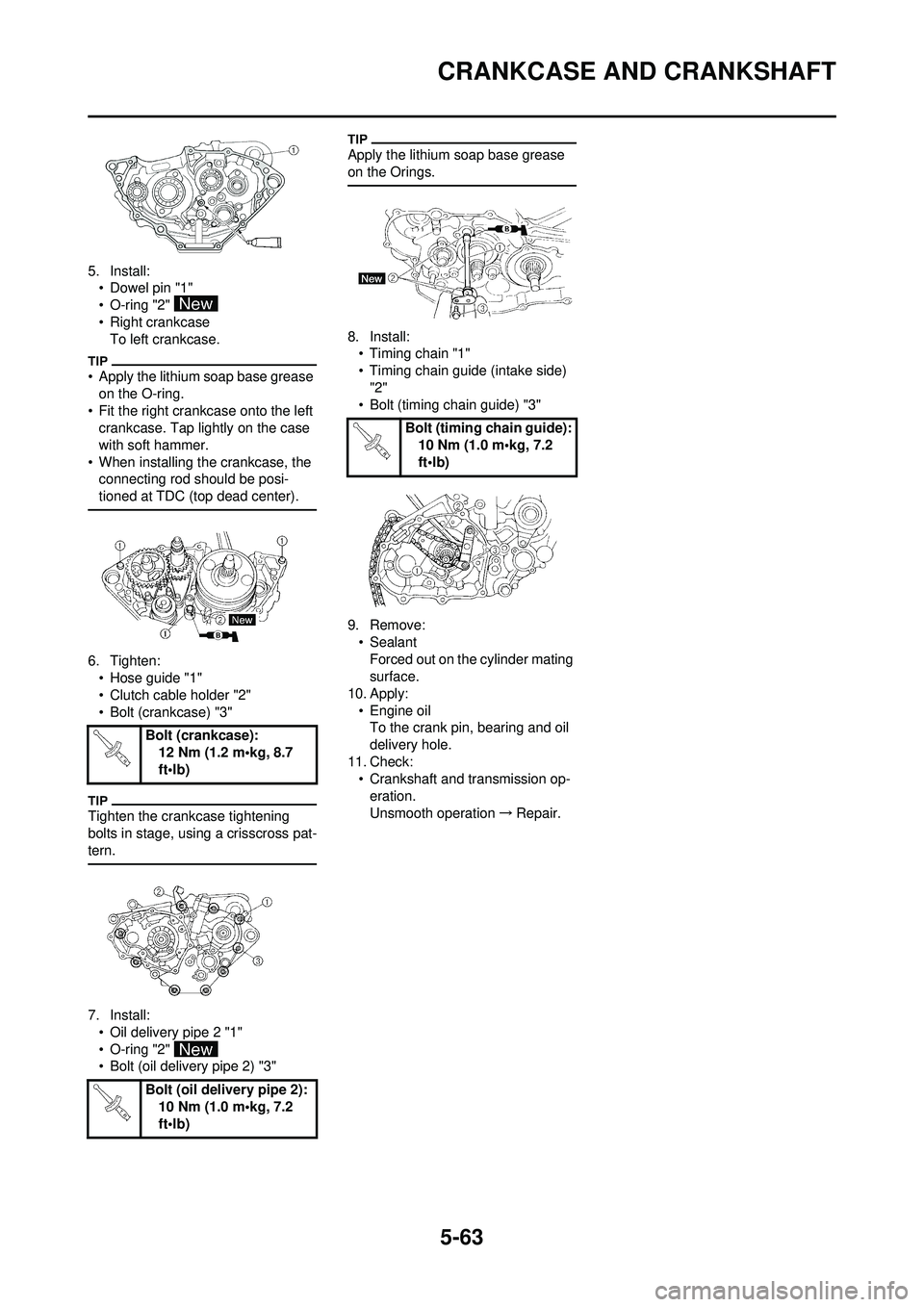
5-63
CRANKCASE AND CRANKSHAFT
5. Install:• Dowel pin "1"
• O-ring "2"
• Right crankcaseTo left crankcase.
• Apply the lithium soap base grease
on the O-ring.
• Fit the right crankcase onto the left crankcase. Tap lightly on the case
with soft hammer.
• When installing the crankcase, the connecting rod should be posi-
tioned at TDC (top dead center).
6. Tighten:
• Hose guide "1"
• Clutch cable holder "2"
• Bolt (crankcase) "3"
Tighten the crankcase tightening
bolts in stage, using a crisscross pat-
tern.
7. Install:• Oil delivery pipe 2 "1"
• O-ring "2"
• Bolt (oil delivery pipe 2) "3"
Apply the lithium soap base grease
on the Orings.
8. Install:• Timing chain "1"
• Timing chain guide (intake side)
"2"
• Bolt (timing chain guide) "3"
9. Remove: • Sealant
Forced out on the cylinder mating
surface.
10. Apply:
• Engine oilTo the crank pin, bearing and oil
delivery hole.
11. Check: • Crankshaft and transmission op-eration.
Unsmooth operation →Repair.
Bolt (crankcase):
12 Nm (1.2 m•kg, 8.7
ft•lb)
Bolt (oil delivery pipe 2): 10 Nm (1.0 m•kg, 7.2
ft•lb)
Bolt (timing chain guide):10 Nm (1.0 m•kg, 7.2
ft•lb)
Page 168 of 232
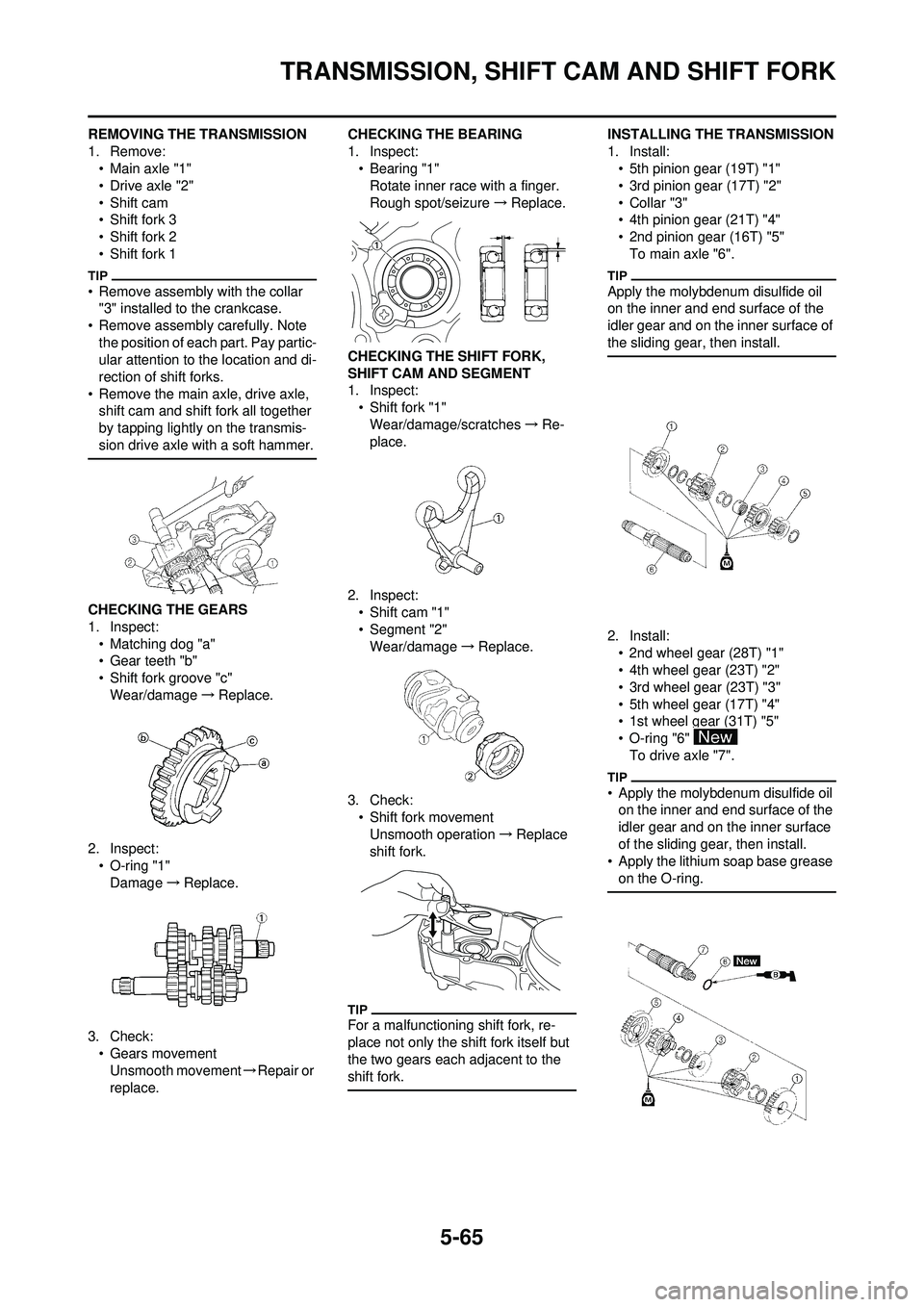
5-65
TRANSMISSION, SHIFT CAM AND SHIFT FORK
REMOVING THE TRANSMISSION
1. Remove:• Main axle "1"
• Drive axle "2"
• Shift cam
• Shift fork 3
• Shift fork 2
• Shift fork 1
• Remove assembly with the collar "3" installed to the crankcase.
• Remove assembly carefully. Note
the position of each part. Pay partic-
ular attention to the location and di-
rection of shift forks.
• Remove the main axle, drive axle, shift cam and shift fork all together
by tapping lightly on the transmis-
sion drive axle with a soft hammer.
CHECKING THE GEARS
1. Inspect:
• Matching dog "a"
• Gear teeth "b"
• Shift fork groove "c"Wear/damage →Replace.
2. Inspect: • O-ring "1"
Damage →Replace.
3. Check: • Gears movementUnsmooth movement →Repair or
replace. CHECKING THE BEARING
1. Inspect:
•Bearing "1"Rotate inner race with a finger.
Rough spot/seizure →Replace.
CHECKING THE SHIFT FORK,
SHIFT CAM AND SEGMENT
1. Inspect: • Shift fork "1"Wear/damage/scratches →Re-
place.
2. Inspect: • Shift cam "1"
• Segment "2"
Wear/damage →Replace.
3. Check: • Shift fork movementUnsmooth operation →Replace
shift fork.
For a malfunctioning shift fork, re-
place not only the shift fork itself but
the two gears each adjacent to the
shift fork.
INSTALLING THE TRANSMISSION
1. Install: • 5th pinion gear (19T) "1"
• 3rd pinion gear (17T) "2"
•Collar "3"
• 4th pinion gear (21T) "4"
• 2nd pinion gear (16T) "5"
To main axle "6".
Apply the molybdenum disulfide oil
on the inner and end surface of the
idler gear and on the inner surface of
the sliding gear, then install.
2. Install:• 2nd wheel gear (28T) "1"
• 4th wheel gear (23T) "2"
• 3rd wheel gear (23T) "3"
• 5th wheel gear (17T) "4"
• 1st wheel gear (31T) "5"
• O-ring "6" To drive axle "7".
• Apply the molybdenum disulfide oil on the inner and end surface of the
idler gear and on the inner surface
of the sliding gear, then install.
• Apply the lithium soap base grease on the O-ring.
Page 169 of 232
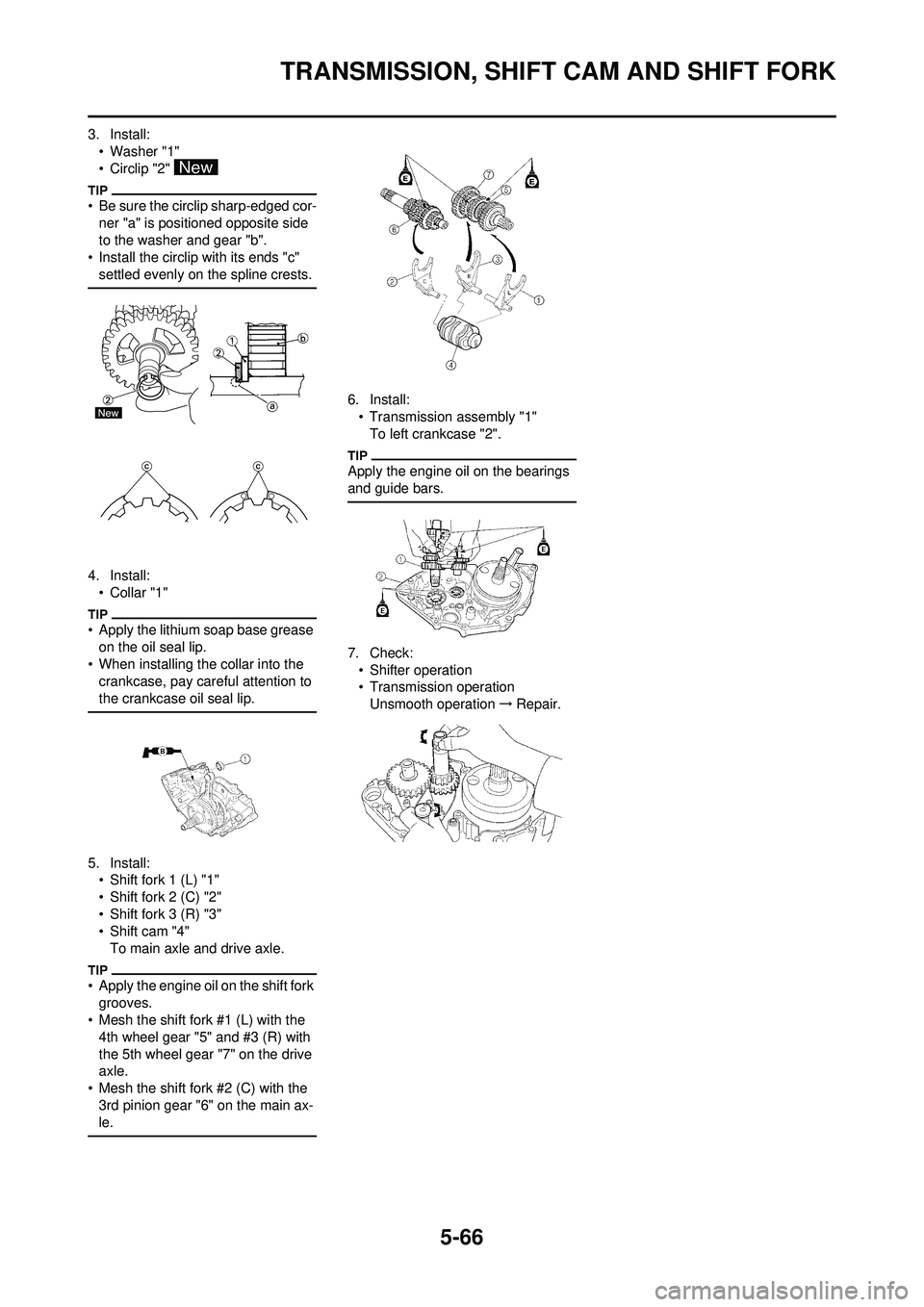
5-66
TRANSMISSION, SHIFT CAM AND SHIFT FORK
3. Install:• Washer "1"
• Circlip "2"
• Be sure the circlip sharp-edged cor-ner "a" is positioned opposite side
to the washer and gear "b".
• Install the circlip with its ends "c" settled evenly on the spline crests.
4. Install:•Collar "1"
• Apply the lithium soap base grease on the oil seal lip.
• When installing the collar into the crankcase, pay careful attention to
the crankcase oil seal lip.
5. Install:• Shift fork 1 (L) "1"
• Shift fork 2 (C) "2"
• Shift fork 3 (R) "3"
• Shift cam "4"To main axle and drive axle.
• Apply the engine oil on the shift fork
grooves.
• Mesh the shift fork #1 (L) with the 4th wheel gear "5" and #3 (R) with
the 5th wheel gear "7" on the drive
axle.
• Mesh the shift fork #2 (C) with the
3rd pinion gear "6" on the main ax-
le.
6. Install:• Transmission assembly "1"To left crankcase "2".
Apply the engine oil on the bearings
and guide bars.
7. Check:• Shifter operation
• Transmission operation
Unsmooth operation →Repair.
Page 214 of 232

7-5
ELECTRIC STARTING SYSTEM
3. Inspect:• Secondary coil resistanceOut of specification →Replace.
4. Inspect: • Sealed portion of ignition coil "a"
• Spark plug terminal pin "b"
• Threaded portion of spark plug "c"Wear →Replace.
CHECKING THE AC MAGNETO
1. Inspect: • Pickup coil resistance
Out of specification →Replace. CHECKING THE NEUTRAL
SWITCH
1. Inspect:
• Neutral switch conduction
Not conductive while it is in neutral →
Replace.
Conductive while it is engaged →Re-
place.
Set the tester selection position to " Ω
× 1".
CHECKING THE CDI UNIT
Check all electrical components. If no
fault is found, replace the CDI unit.
Then check the electrical compo-
nents again.
ELECTRIC STARTING
SYSTEM
STARTING CIRCUIT CUT-OFF
SYSTEM OPERATION
If the main switch is set to "ON", the
starter motor can only operate if at
least one of the following conditions is
met:
• The transmission is in neutral (the neutral switch is closed).
• The clutch lever is pulled to the han- dlebar (the clutch switch is closed).
The starting circuit cut-off relay pre-
vents the starter motor from operating
when neither of these conditions has
been met. In this instance, the start-
ing circuit cut-off relay is open so cur-
rent cannot reach the starter motor.
When at least one of the above con-
ditions has been met the starting cir-
cuit cut-off relay is closed and the
engine can be started by pressing the
start switch.
WHEN THE TRANSMISSION IS IN
NEUTRAL
WHEN THE CLUTCH LEVER IS
PULLED TO THE HANDLEBAR 1. Battery
2. Main fuse
3. Main switch
4. Starting circuit cut-off relay
5. Start switch
6. Diode
7. Clutch switch
8. Neutral switch
9. Starter relay
10. Starter motor
Tester (+) lead
→Orange lead "1"
Tester (-) lead →Spark plug termi-
nal "2"
Secondary coil resis- tance Tester se-
lector posi- tion
4.6–6.8
k Ωat 20 °C
(68 °F) k
Ω × 1
Tester (+) lead →Red lead "1"
Tester (-) lead →White lead "2"
Pickup coil resistance Tester se-
lector posi-
tion
248–372 Ω
at 20 °C (68 °F) Ω × 100
Tester (+) lead
→Sky blue lead "1"
Tester (-) lead →Ground "2"
Result Conductive (while gear
is in neutral)